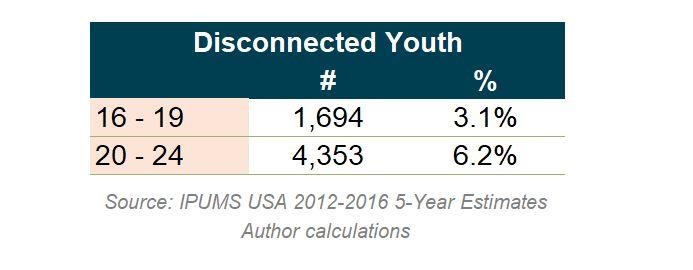Several years ago, the Brookings Institution published a report about individuals they termed “disconnected youth.” In that analysis, this group was 16- to 24-year-olds who were engaged in neither the educational system nor the workforce. The intent of the analysis was to highlight individuals who are “at a pivotal point as they transition into adulthood” but are not engaging with a career or furthering their educational standing.
We have found this to be a valuable marker of potential young talent in our region, and have recreated this data for our local level over the past several years.
Updated Data from 2016
In the Grand Rapids-Wyoming Metropolitan Statistical Area (MSA), which includes Barry, Kent, Montcalm, and Ottawa Counties, the rate of disconnected youths age 16 to 19 is 3.1 percent in 2016, with a nearly-double rate of 6.2 percent for the 20 to 24 age group.

Of the over-6,000 disconnected youth in the Grand Rapids area, just under 72 percent are in the 20 to 24 age group. This makes sense in that many individuals who are 16, 17, and 18 years old are likely still in high school, which would mean they are not classified as disconnected.
How We Calculate This Figure
Using the methodology described by the team at Brookings, this indicator is found using American Community Survey microdata released through the IPUMS program at the University of Minnesota. Because of the small sample size for this analysis, we used the 2012-2016 5-year microdata. While we typically try to analyze data at a regional (West Michigan) level, this microdata was most reliably used at the MSA level.
To be considered “disconnected,” an individual must meet the following criteria:
- They are between the ages of 16-24,
- They are not working (can be unemployed or out of the labor force),
- They are not enrolled in school,
- They are living below 200 percent of the federal poverty line,
- They have educational attainment of less than an associate’s degree,
- They are not in the Armed Forces, and
- They are not living in group quarters.
As explained by the Brookings Institution, the poverty and educational attainment markers are included to highlight young individuals who might be considered “at-risk,” which is really what this indicator is trying to convey.
Future Data Topics
Have you been enjoying these “Data Points” blogs? Are you interested in other data? Let us know what topics you’d like to know more about on our Twitter @WMTalent2025! We’d like to crunch some numbers that you’re interested in.


